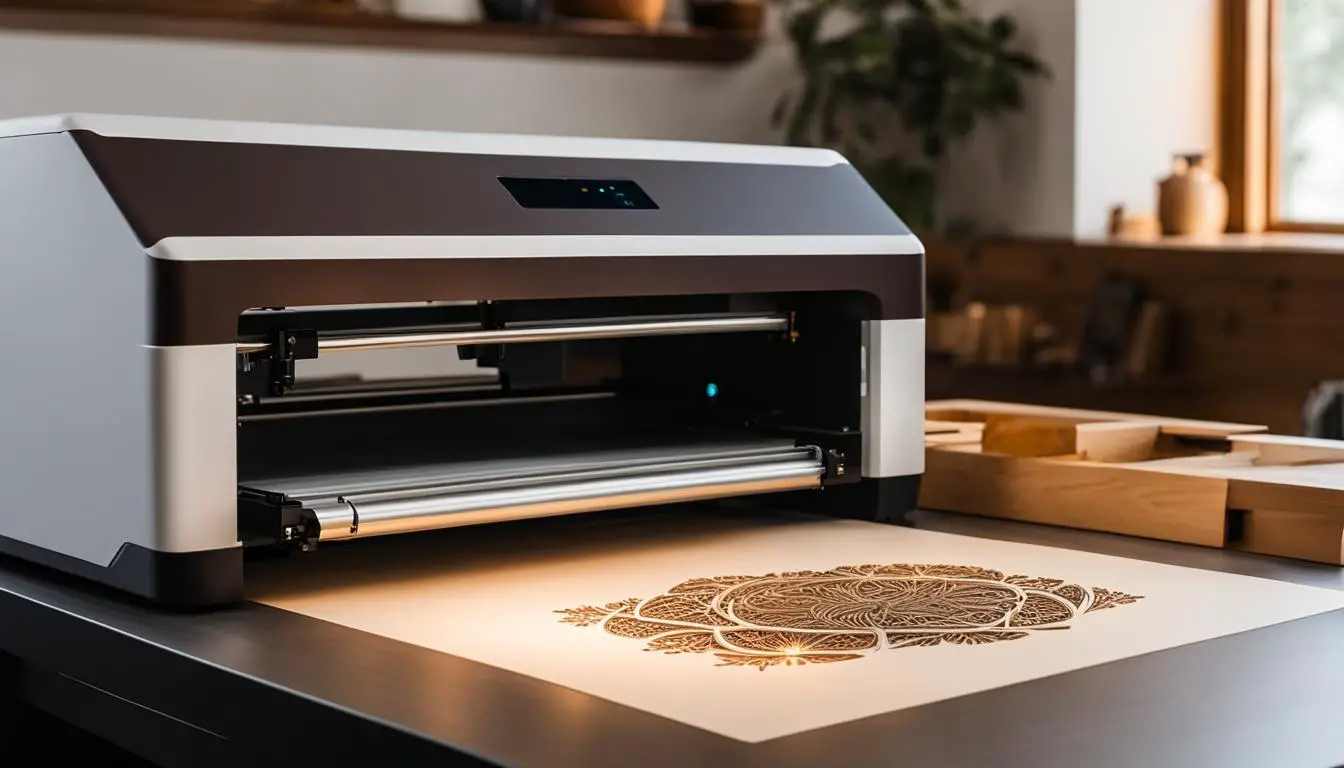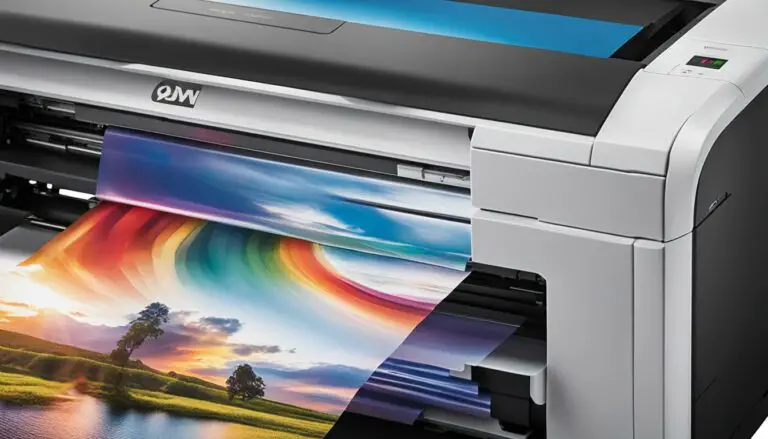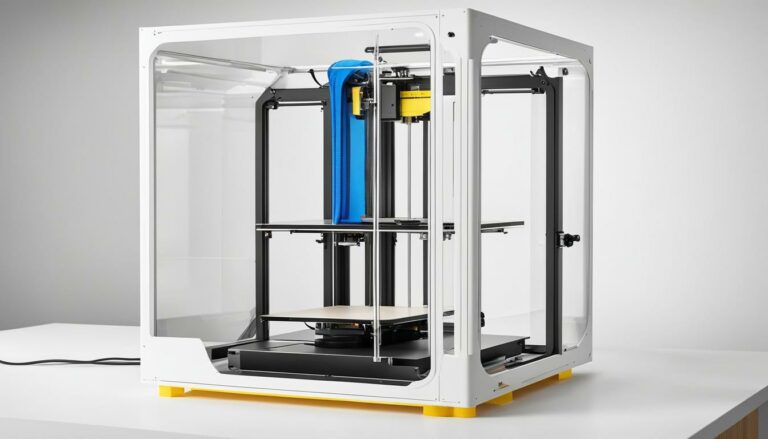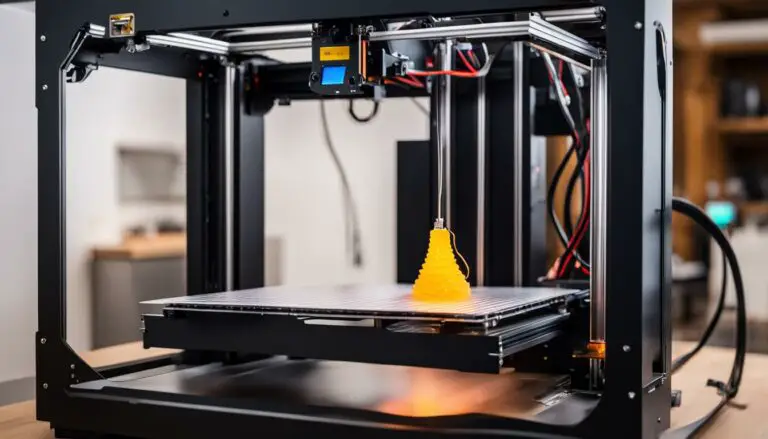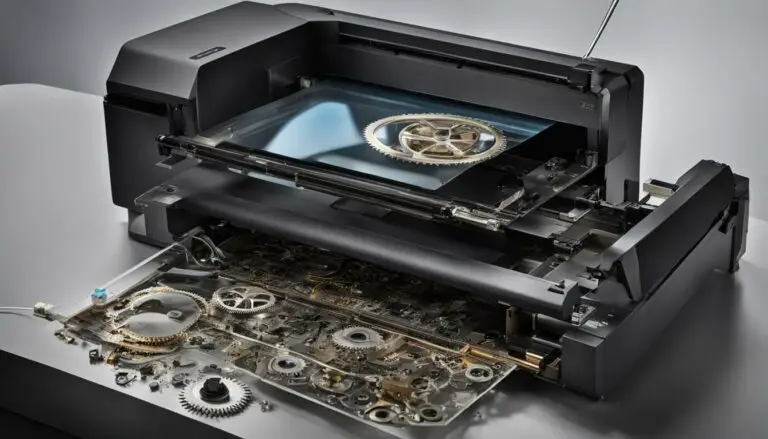Unlock Glowforge Passthrough Potential with Tips
Originally posted on January 30, 2024 @ 12:45 am
The addition of the Glowforge passthrough feature has revolutionized the world of laser cutting enthusiasts by enabling them to cut or engrave longer materials that exceed the machine’s standard workspace. This incredible capability has unlocked endless opportunities for creating elaborate and sizable designs.
Many users have discovered a clever hack that unlocks the passthrough feature on their Glowforge Basic or Plus. By utilizing the front flap of the machine as a makeshift passthrough, they can easily cut down 24″ sheets to fit the Glowforge while staying warm inside their house. It’s a brilliant solution for those who want to work with longer materials without investing in a larger machine!
However, it’s important to note that performing this hack comes with certain safety concerns. Increased exposure to fumes and limited eye safety are among the potential risks. We always prioritize safety and recommend that you follow the guidelines provided by Glowforge to protect yourself and others while using the passthrough hack.
Key Takeaways:
- The Glowforge passthrough feature allows users to work with longer materials that wouldn’t fit within the machine’s standard workspace.
- Tricking the machine into thinking the lid is closed enables users to use the front flap as a makeshift passthrough.
- Performing the passthrough hack comes with safety concerns, such as increased exposure to fumes and potential eye safety risks.
- We recommend prioritizing safety and following Glowforge’s guidelines when using the passthrough hack.
- The passthrough hack is a cost-effective solution for cutting or engraving longer materials without investing in a larger machine.
How to Hack Glowforge Passthrough
To unlock the full potential of the Glowforge passthrough feature, you can try a simple hack using two magnets and some tape. With this hack, you’ll be able to use the front flap of your Glowforge Basic or Plus as a makeshift passthrough, allowing you to cut or engrave longer materials that wouldn’t fit within the machine’s standard workspace.
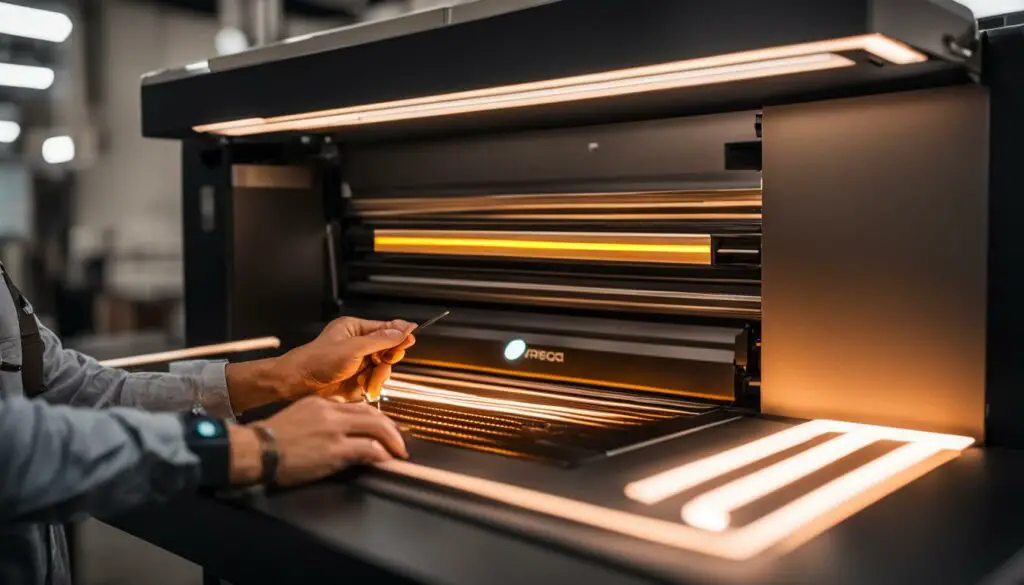
To begin, place the two magnets on the lower lip of the Glowforge’s lid in a specific position. This strategic placement tricks the machine into thinking that the lid is closed, even though the front flap is open. With this workaround, you can smoothly run the machine with the flap as your passthrough.
It’s important to note that performing this hack comes with certain safety concerns. Always prioritize safety and take the necessary precautions when using the passthrough hack. This includes following eye safety guidelines and considering increased exposure to fumes. Additionally, it’s recommended to use a gate or an opaque piece of material to block some of the fumes and light from the open machine.
The Glowforge passthrough hack opens up new possibilities for working with larger or continuous materials. However, it’s essential to be cautious and ensure the safety of both yourself and the machine throughout the process. By taking these precautions, you’ll be able to make the most of the Glowforge passthrough modification.
Prepping the Material to Cut
Before utilizing the Glowforge passthrough hack, proper preparation of the material is essential to ensure a successful cutting process. Follow these tips and techniques to optimize your results:
- Mark the length: Start by marking the desired length on the longer sheet of material. This will help you align the area to be cut accurately and efficiently.
- Align in Glowforge Interface: Use a single line in the Glowforge Interface to align the marked area. This ensures that the cut will be precisely where you want it and avoids any unnecessary mistakes.
- Secure the material: To prevent the material from popping up during the cutting process, it’s important to secure it properly. Pin down the material above and below the cut area using tape or clamps. This will keep the material flat and stable, avoiding any potential damage to the machine.
- Block excess light and fumes: As the Glowforge passthrough exposes a larger area, it’s recommended to use a solid piece of material to block excess light and fumes from escaping. This not only enhances visibility but also helps in maintaining a safer environment.
- Avoid moving the material: Once the cutting process begins, it’s crucial to avoid moving the material. Any movement can lead to misalignment and compromises the accuracy of the cutting. Make sure the material remains stationary throughout the process.
- Stay vigilant: Always keep an eye on the Glowforge machine while it’s cutting. Never walk away from the machine during the cutting process to ensure complete control and avoid any potential mishaps.
By following these tips and techniques, you can effectively prepare your material for the Glowforge passthrough hack, ensuring precise and successful cutting results.
Using the Passthrough with Illustrator
For users who prefer using Illustrator, we have a specific technique for utilizing the Glowforge passthrough feature. Follow these steps to make the most of this functionality.
- Create the design at the correct size: Ensure that your design is set to the dimensions that will fit within the Glowforge’s workspace when using the passthrough feature.
- Outline the text: To ensure smooth cutting, outline any text in your design. This will convert the text into a shape for precise cutting.
- Join letters into one shape: If your design includes words, join the letters together to form a single shape. This will help in cutting the design seamlessly.
- Create a guide: To cut the word into sections that fit within the Glowforge’s workspace, create a guide using lines or shapes in Illustrator. This guide will determine where the word should be cut apart.
- Cut the word along the guide lines: Using the guide as a reference, cut the word apart where it crosses the guide lines. This will divide the word into sections that can be individually cut using the Glowforge passthrough.
- Assign different color strokes: To differentiate the sections, assign each section a different color stroke. This will help in organizing the sections for cutting.
- Rotate and prepare for cutting: Rotate the sections as needed to fit within the Glowforge’s workspace. Ensure that each section is properly aligned with the passthrough feature.
By following these steps in Illustrator, you can effectively use the Glowforge passthrough feature to cut intricate designs that span longer materials. This technique provides flexibility and precision in laser cutting projects.
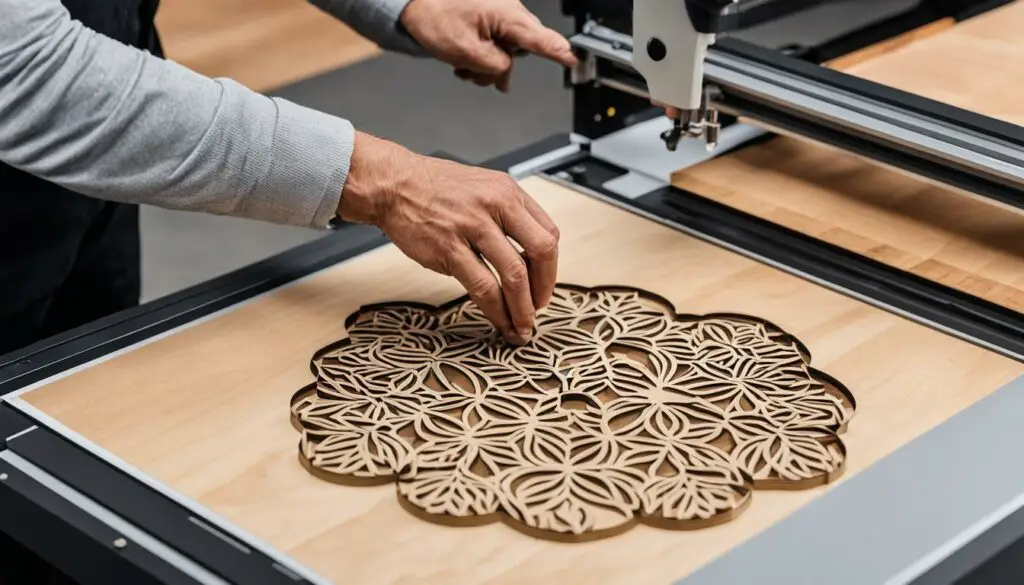
Passthrough Design Example:
| Section | Description |
|---|---|
| 1 | A guide is created to cut the word “GLOWFORGE” into sections. |
| 2 | The word is cut apart along the guide lines, creating individual sections. |
| 3 | Each section is given a different color stroke for clarity. |
| 4 | The sections are rotated and aligned within the Glowforge’s workspace. |
With the ability to use the Glowforge passthrough feature in conjunction with Illustrator, you have the power to create intricate designs and bring your ideas to life with precision.
How to Use the Passthrough
Once you’ve successfully hacked your Glowforge and enabled the passthrough feature, it’s time to learn how to use it effectively. Follow these simple steps to make the most out of your Glowforge passthrough:
- Secure the tray: Before you begin, ensure that the tray is securely anchored in the machine. You can use boots or tape to keep the tray in place, preventing any movement during the cutting process.
- Align the material: To ensure accurate cuts, it’s essential to align the material correctly. Printing out and using passthrough jigs can be very helpful in achieving the desired alignment. Simply place the material within the jigs to guide its placement in the machine.
- Score the index marks: Before cutting, it’s recommended to score the index marks on the material. Scoring helps ensure proper alignment and prevents any accidental misalignment during the cutting process. Check the alignment after scoring to make sure everything lines up correctly.
- Cut section by section: Once the index marks are scored, you can start cutting the material. It’s crucial to cut section by section, checking for complete cut through before moving on to the next section. This approach allows you to maintain accuracy and prevent any incomplete cuts that can lead to wasted material.
- Check alignment with jigs: After each section is cut, check the alignment against the index marks on the jigs. This double-check ensures that your cuts remain precise and accurate throughout the process.
Remember to take your time and be meticulous when using the passthrough feature. Attention to detail and following these tips will help you achieve excellent results with your Glowforge.
Troubleshooting Tips for Passthrough Usage
If you encounter any issues while using the passthrough feature, here are some troubleshooting tips:
“My cuts are not aligned properly.”
Ensure that the material is securely placed within the jigs and that the index marks are scored accurately. Double-check the alignment with each new section to maintain accuracy.
“The material is moving during the cutting process.”
Make sure the tray is securely anchored using boots or tape. This will prevent any unwanted movement that may occur during the cutting process.
“I can’t achieve a complete cut through.”
Check the power and speed settings for your material. Adjusting these settings can help achieve a clean cut through. Additionally, ensure that the material is flush against the tray and jigs to avoid any interference.
By following these tips and troubleshooting steps, you’ll be able to make the most out of your Glowforge passthrough feature and create stunning projects with ease.
Conclusion
The Glowforge passthrough feature, along with the glowforge passthrough hack, has revolutionized the possibilities for cutting and engraving longer materials. By utilizing this feature in a safe and responsible manner, users can fully explore the potential of their Glowforge machine. Whether you opt to use the hack or Glowforge’s Pro Passthrough software, it is essential to prioritize safety and adhere to the guidelines provided by the company.
The passthrough feature not only enables the cutting and engraving of larger materials but also allows for the creation of continuous designs that were previously limited by the machine’s standard workspace. It opens up a world of new opportunities and expands the scope of laser cutting projects.
Whether you’re a hobbyist or a professional, the Glowforge passthrough feature and the passthrough hack provide you with the tools to bring your creative visions to life. Seamlessly working with longer and continuous materials, you can now push the boundaries of your projects and create stunning, intricate designs.
FAQ
What is the Glowforge passthrough feature?
The Glowforge passthrough feature allows users to cut or engrave longer materials that would not fit completely within the machine’s standard workspace.
How can I hack the Glowforge passthrough feature?
To hack the Glowforge passthrough feature, you will need two magnets and some tape. By placing the magnets on the lower lid lip in a specific position, you can trick the Glowforge into thinking the lid is closed and use the front flap as a makeshift passthrough. However, please note that this hack should be done at your own risk and safety precautions must be followed.
What safety precautions should I take when using the passthrough hack?
When using the passthrough hack, it’s important to prioritize safety. This includes avoiding eye safety concerns and increased exposure to fumes. Users should always ensure proper ventilation, take breaks when needed, and consider using a gate or opaque material to block fumes and light from the open machine.
How should I prep the material before using the passthrough hack?
Before using the passthrough hack, it’s important to properly prep the material you want to cut. This includes marking the length on the longer sheet, using a single line in the Glowforge Interface for alignment, pinning down the material to prevent it from popping up, and blocking light and fumes with a solid piece of material.
Can I use the passthrough feature with Illustrator?
Yes, if you prefer using Illustrator, there is a specific process for utilizing the passthrough feature. This involves creating the design at the correct size, outlining the text, joining the letters together into one shape, creating a guide to cut the word into sections that fit within the workspace, cutting the word apart where it crosses the guide lines, and preparing each section for cutting using the passthrough.
How do I use the passthrough feature?
To use the passthrough feature, it’s important to have a secure tray or use boots or tape to anchor the tray in the machine. Printing out and using the passthrough jigs can help with aligning the material correctly. It’s recommended to score the index marks on the material for proper alignment, cut the material section by section, and always check for complete cut through before moving on to the next section. Aligning the material with the index marks on the jig is crucial for accuracy.
What are the benefits of the Glowforge passthrough feature?
The Glowforge passthrough feature, whether by using the hack or official software, has unlocked the potential for cutting or engraving longer materials. This opens up new possibilities for laser cutting projects and allows users to work with larger or continuous materials.

